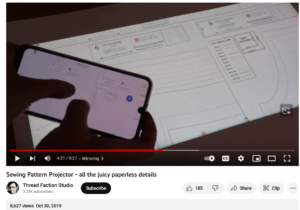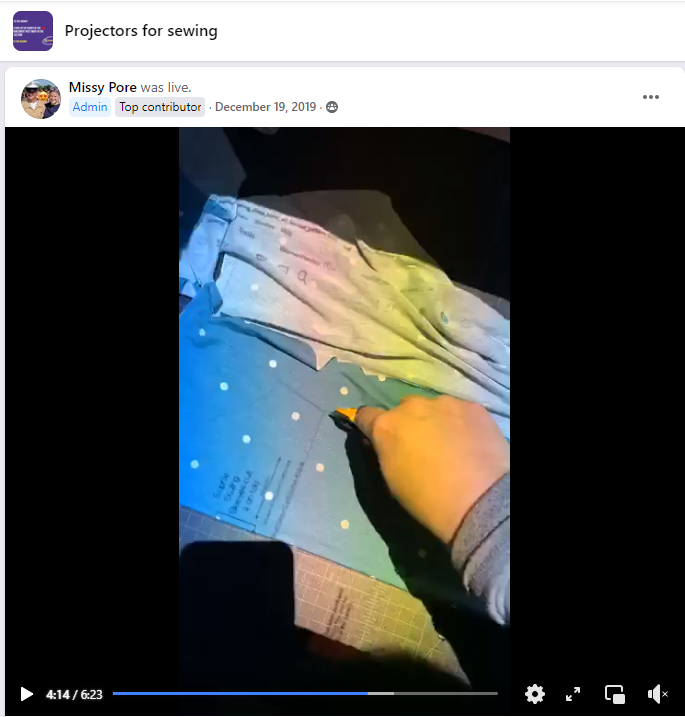Projector sewing has become a social movement, as collaboration, knowledge sharing, and innovating are core values that propel the technology to become mainstream, and quickly becoming the most popular way to cut sewing patterns. Here are some highlights of how projector sewing became so popular in such a short time:
2019: Founding of this Projectors for Sewing FB group by Missy Pore
The story of how Missy was the first person to take leadership and promote projector sewing to the masses is told in this interview with Branalyn Dailey, another projector sewing original promoter.
This video Missy posted demonstrating how she set her projector up and how easy cutting directly from a projector could be, was the catalyst that set the sewing community ablaze.

In 2019 and a bit earlier, there were others trying out various ways to project patterns, including this popular video by Thread Faction Studio.
Missy’s leadership in creating a place for people interested in projector sewing allowed the collective knowledge of the burgeoning projector community to grow exponentially. Members from around the world immediately shared what projector they tried and successes and challenges they experienced, and solutions to obstacles were soon found.
2020: Development of calibration process and our Squares and Rectangles Calibration Tool PDF
Over time, with the feedback from thousands of members in the Projectors Sewing Facebook group calibrating their projector and projecting patterns, we learned the basic “rules” that made projector sewing easier: all PDFs have the same scale (unless they are corrupted) so we can use our “calibration zoom” in all patterns, we need 720p native resolution projectors, uneveness in surface that pattern is projected on will be seen in distortion of pattern lines, so surface must be as flat as possible, and aiming for 99% accuracy (accurate to within 1/4″-2/8″ on a 16″x24″ projected rectangle in the Squares and Rectangles Calibration Tool) is as accurate as home printed patterns (and more accurate in many cases).
The calibration method and proof that projector sewing could be as accurate or even more accurate than home printing was the key that allowed the movement to gain momentum, as the main question “how do you know if your pattern is projected at accurate scale” was finally answered.
2021: PDFStitcher becomes go-to tool to make patterns projectable
This free, open-source, program created and updated by Charlotte Curtis helped people create their own projector PDF files from PDF pattern printing files, and enhance visibility of size layers.
2020-2021: Popular indie sewing pattern designers and influencers join the projector sewing movement and make videos to demonstrate and help educate
Videos by Morgan Donner, Needle and the Belle/Aaronica Cole, Minimalist Machinist, Ellie and Mac, and many others on Instagram, TikTok, and YouTube help thousands of people learn about projector sewing.
Pattern companies like Ellie and Mac Patterns, George+Ginger, Greenstyle Creations, Jalie, Rad Patterns, Seamwork, and many others began releasing new patterns with projector files, and some began the work of adding projector files to older patterns.
2022: Growth in YouTube videos and other social media about making digital pattern adjustments for fitting, and pattern hacking, including the creation of the Affinity Designer for Pattern Alteration and Designing Facebook group.
2023: Release of Inkscape v 1.3
The newest version of Inkscape which now imports layers in PDFs, allows people to learn just one (free!) software for all their needs: calibrating/scaling, accessing size layers, viewing/enhancing patterns for projecting, digital editing patterns for fitting adjustments and hacking.
What next step do you think is needed for the continued development of the projector sewing movement?
